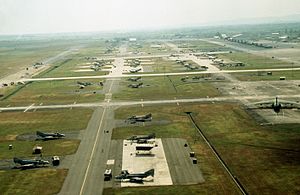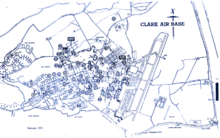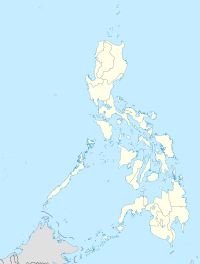- Clark Air Base
-
For the civil use of the land holdings after December 1991, see Clark Freeport Zone. For the civil use of the airfield after December 1991, see Diosdado Macapagal International Airport. For other air fields, see Clark Field (disambiguation).
Clark Air Base Part of United States Pacific Air Forces (PACAF) Located at Angeles City, Luzon Island, Philippines
Clark Air Base in 1989Type Air Base Coordinates 15°11′09″N 120°33′37″E / 15.18583°N 120.56028°ECoordinates: 15°11′09″N 120°33′37″E / 15.18583°N 120.56028°E Built September 1, 1903 Built by United States In use 1903-1991 (US) 1992-Present (Clark Freeport Zone) Current
conditionRenovated Current
owner Philippines
PhilippinesControlled by Philippine Government Clark Air Base is a former United States Air Force base on Luzon Island in the Philippines, located 3 miles west of Angeles City, about 40 miles northwest of Metro Manila. Clark Air Base was an American military facility from 1903 to 1991. The base covered 14.3 square miles (37 km²) with a military reservation extending north that covered another 230 square miles (596 km²).
The base was a stronghold of the combined Filipino and American forces during the end of World War II, and until 1975, it was a backbone of logistical support during the Vietnam War. Following the departure of American forces in 1991, the base eventually became the site of Diosdado Macapagal International Airport and the Clark Freeport Zone.
Contents
History
- For full details, see History of Clark Air Base.
- For information on Clark after its closure, see Clark Freeport Zone and Diosdado Macapagal International Airport.
Clark Air Base was originally established as Fort Stotsenburg in Sapang Bato, Angeles City in 1903 under control of the U.S. Army. A portion of Fort Stotsenburg was officially set aside for the Aviation Section of the Signal Corps and named Clark Field in September of 1919. Clark served as a landing field for medium bombers and accommodated half of the heavy bombers stationed in the Philippines during the 1930s. It was very large for a landing field of the day. In the late summer and fall of 1941, many aircraft were sent to Clark in anticipation of war with Imperial Japan.
The base was overrun by Japanese forces in early January 1942. The base then became a major center for staging Japanese air operations. Japanese aircraft flying out of Clark participated in the Battle of Leyte Gulf, considered to be the largest naval battle of the Second World War.[1] [2]
During the war, the Allied prisoners of the Bataan Death March passed by the main gate of Clark Air Base, as the soldiers followed the direction of the railway tracks north, towards Camp O'Donnell. Clark Air Base was recaptured by Americans in January 1945, after three months of fierce fighting in the Philippines.
Clark grew into a major American air base during the Cold War, serving as an important logistics hub during the Vietnam War. The base was later closed due to the refusal by the Philippine Government to renew the lease on the base. After extensive damage from the Mount Pinatubo eruption, the Philippine Government attempted to reopen base lease talks, but terms could not be reached and the lease was not extended.
In November 1991, the United States Air Force lowered the Stars and Stripes and transferred Clark Air Base to the Philippine government. With the United States military's withdrawal from Clark, the base was systematically looted and was left abandoned for several years. It finally became the Clark Freeport Zone and the site of Clark International Airport (CIA), renamed to Diosdado Macapagal International Airport (DMIA) in 2003.[citation needed]
Military units
- See the article List of military units of Clark Air Base.
During much of the Cold War, Clark Air Base's activity largely revolved around the 3rd Tactical Fighter Wing and its fleet of F-4 Phantom II fighter jets. It also hosted an interceptor squadron and a flight school, all of which flew a variety of other combat aircraft. Transient aircraft of many types, especially cargo jets, were very common. Fighter planes regularly visited to participate in aerial warfare exercises at Crow Valley about 30 miles (50 km) to the northwest. In 1973 headquarters for the 374th Tactical Airlift Wing was transferred to Clark Air Base. With this move came two squadrons of C-130E transport aircraft, the 21st Tactical Airlift Squadron and the 776th Tactical Airlift Squadron.
Clark was served regularly by cargo and passenger flights to and from Andersen AFB, Guam; Kadena AB, Japan; Diego Garcia; Jakarta, Indonesia; Bangkok and Ubon Thailand; and Saigon, Vietnam (until 1975). During the 1970s, passengers arrived via Trans International Douglas DC-8 and Braniff International DC-8s (the Pickle and the Banana) flights from Travis AFB, California (via Honolulu and Guam). By 1980, the base had grown to such an extent that weekly Flying Tigers Boeing 747 service to St. Louis (via Kadena AB Japan; Anchorage; and Los Angeles) had begun. The 747 service was taken over by Tower Air sometime in the late 1980s, and was augmented with a weekly Hawaiian Airlines L-1011 or Douglas DC-8 to Guam-Honolulu-Los Angeles.
Culture
Clark Air Base was arguably the most urbanized military facility in history, and was the largest American base overseas. At its peak around 1990, it had a permanent population of 15,000. It had a base exchange, a large commissary, a small shopping arcade, a branch department store, cafeterias, teen centers, a hotel, miniature golf, riding stables, and other concessions.
Recreation
Angeles City bars were legendary, particularly around the red-light district on Fields Avenue. As a result, Clark's servicemen's clubs were under considerable pressure to serve its members with wholesome entertainment. All three were large-scale operations: the Officer's Club (CABOOM) near the parade ground, the Top Hat Club for NCOs near Lily Hill (moved to near the Silver Wing around 1986), and the Coconut Grove Airmen's Club with indoor palm trees. The NCO Club was a very extensive operation and operated an upscale dining room, an in-house thrift shop, and a calendar of daily activities. It regularly brought major bands and artists from the United States to perform.
At least a hundred sponsored clubs and organizations were active on the base, including Knights of Columbus, a Latino American club, martial arts dojos, and more. Two major movie theaters operated daily: the Bobbitt Theater which played first-run films, and the Kelly Theater which showed older releases. By 1988 the Kelly no longer showed films at all but was used for Commander's Calls and large squadron sized meetings. In the late 1960s and early 1970s movies were also shown at the Bamboo Bowl (the football stadium on base).
The Bamboo Bowl, later renamed Challenger Field, was largely used for high school football games as the school did not have its own athletic field. In addition to high school football games it also hosted rec league football games for ages 8–18. The high school football teams were actually part of the rec league. The base's sole high school, Wagner High, actually had multiple football teams. It was also used for the base's 11 man tackle football league which not only included teams from Clark but from Subic Naval Base as well.
To keep the residents entertained at home, Clark had a very active broadcast center called FEN, or Far East Network Philippines, a division of American Forces Network. A television station broadcast on Channel 8 until 1981, then Channel 17 afterward. It showed about 20 hours per day of syndicated programs from the "big three" networks in the United States, with local news and talk programs. This content was locally syndicated until 1983 when it began airing live programming by satellite from Los Angeles. FEN had two 24-hour radio stations: an AM station which broadcast news and popular music, and stereo FM which was dedicated to easy-listening and classical music. G.I.s could also receive local Filipino T.V. which aired newer American shows than F.E.N. did. Unlike the local T.V. stations in Europe they were broadcast in the same format as American T.V. and not dubbed into Tagalog.
Two major annual events at Clark were the annual Chili Cookoff, held near the Silver Wing recreation center around September, and the Happening On the Green ("the HOG"). The HOG was a major carnival held on a designated weekend in February which attracted thousands of residents. Amusements and rides were built and operated not only by Filipino entertainment contractors but also by individual Air Force units seeking to boost unit morale, showcase their talents, and raise funds.
Clark's unique size and history allowed it to develop its own supernatural lore. By the 1970s, the Filipino "white lady" legend had established itself at Clark. Most variations of the story involved a young woman dressed in white who would hail a taxi late at night, and then would vanish from the vehicle enroute. More recently, the TV series Ghost Hunters International has done an investigation at the hospital.
Education
The Department of Defense Dependents Schools (DoDDS) operated six schools in Clark, serving children from kindergarten to twelfth grade.
- Elementary schools (kindergarten-5th grade): MacArthur Elementary School, V. I. Grissom Elementary School, and Wurtsmith Elementary School. The latter two were located in the hill housing area.
- Middle schools (6th-8th grade): Lily Hill Middle School, and Wagner Middle School. The latter primarily served the hill housing area and officer dependents.
- High school: Wagner High School, otherwise known as Wurtsmith Memorial High School in the 1960s and Clark Dependent School in the 1950s.
Additionally, Clark was also home to several community colleges, namely the Pacific Far East Campus of Central Texas College. Classes were typically held in the evenings at Wagner High School.
Climate
Clark Air Base experienced two distinct seasons: a dry season from November through April, with a wet season from May through October. From 1953 to 1991, the mean daily low was 73.6°F and the mean daily high was 88.1°F, with April being warmest and January coolest. The average annual rainfall was 78.39 inches.
Climate data for Clark Air Base, Angeles City, Republic of the Philippines (1961-90) Month Jan Feb Mar Apr May Jun Jul Aug Sep Oct Nov Dec Year Average high °F (°C) 86
(30)88
(31)90
(32)93
(34)92
(33)89
(32)87
(31)86
(30)87
(31)87
(31)87
(31)86
(30)88.2
(31.2)Average low °F (°C) 70
(21)71
(22)72
(22)75
(24)76
(24)76
(24)75
(24)75
(24)75
(24)75
(24)73
(23)72
(22)74
(23.2)Precipitation inches (mm) 0.51
(13)0.68
(17.3)1.07
(27.2)2.28
(57.9)7.82
(198.6)11.76
(298.7)15.87
(403.1)16.04
(407.4)12.44
(316)7.29
(185.2)4.04
(102.6)1.54
(39.1)81.34
(2,066)Source: National Climatic Data Center.[3] See also
- Geography of the Philippines
- Military History of the Philippines
- Military History of the United States
- USAAF in the Southwest Pacific
- Clark Freeport Zone
- Diosdado Macapagal International Airport
Other United States Air Force installations in the Philippines:
References
- ^ Morison, Samuel E. (1956). "Leyte, June 1944 – January 1945". History of United States Naval Operations in World War II. XII. Boston: Little & Brown.
- ^ Woodward, C. Vann (1947). The Battle for Leyte Gulf. New York: Macmillan.
- ^ Summary of day data for National Weather Service (U.S.) and Department of Defense (U.S. and foreign) sites, National Climatic Data Center, Asheville NC, 1991.
- Fletcher, Harry R. (1989) Air Force Bases Volume II, Active Air Force Bases outside the United States of America on 17 September 1982. Maxwell AFB, Alabama: Office of Air Force History. ISBN 0912799536
- Martin, Patrick (1994). Tail Code: The Complete History of USAF Tactical Aircraft Tail Code Markings. Schiffer Military Aviation History. ISBN 0887405134.
- Maurer, Maurer (1983). Air Force Combat Units Of World War II. Maxwell AFB, Alabama: Office of Air Force History. ISBN 0892010924.
- Ravenstein, Charles A. (1984). Air Force Combat Wings Lineage and Honors Histories 1947-1977. Maxwell AFB, Alabama: Office of Air Force History. ISBN 0912799129.
- Rogers, Brian (2005). United States Air Force Unit Designations Since 1978. Hinkley, England: Midland Publications. ISBN 1-85780-197-0.
- Sheftall, M.G. (2005). Blossoms in the Wind: Human Legacies of the Kamikaze. NAL Caliber. pp. 480pp. ISBN 0-451-21487-0. http://www.amazon.com/dp/B000EUKRAY/.
 This article incorporates public domain material from websites or documents of the Air Force Historical Research Agency.
This article incorporates public domain material from websites or documents of the Air Force Historical Research Agency.External links
- Clark Air Base website - contains numerous maps and diagrams
- Clark Air Base Vets - database of Clark AB vets from any branch of service
- Satellite picture by Google Maps
- Expatriate Solutions-Clark-Subic Bay
- James Holub's Clark pages
- Clark Air Base Historical Marker Tour
- Clark Field memoirs from 1959-1960
- Philippine International Hot Air Balloon Fiesta 2010 - Clark Pampanga
- History of Clark Field Baptist Church
Commands 
South Vietnam  BasesWings
BasesWingsThailand  BasesWings
BasesWingsOther major
support facilitiesBasesClark (Philippines) · Ching Chuan Kang (Republic of China) · Andersen (Guam) · Kadena (Japan) · Misawa (Japan) USAAF Fifth Air Force in World War II
USAAF Fifth Air Force in World War IIPreviously: Philippine Department Air Force (1941); Far East Air Force (1941-1942) Airfields Pacific USAAF in Australia · USAAF in the Southwest Pacific · USAAF in Okinawa
Units Commands Wings54th Troop Carrier · 85th Fighter · 86th Fighter · 91st Reconnaissance · 308th Bombardment · 309th Bombardment · 310th BombardmentGroupsAir Commando 3rd Air CommandoBombardment 3rd Bombardment · 7th Bombardment · 19th Bombardment · 22nd Bombardment · 27th Bombardment · 38th Bombardment · 43rd Bombardment · 90th Bombardment · 312th Bombardment · 345th Bombardment · 380th Bombardment · 417th BombardmentCombat Cargo 2nd Combat CargoFighter 8th Fighter · 24th Pursuit · 35th Fighter · 49th Fighter · 58th Fighter · 348th Fighter · 475th FighterReconnaissance 6th Reconnaissance · 71st ReconnaissanceTroop Carrier 317th Troop Carrier · 374th Troop Carrier · 375th Troop Carrier · 433rd Troop CarrierSquadrons Bombardment Night Fighter Reconnaissance 2nd Observation · 8th Photographic Reconnaissance · 36th Photographic ReconnaissanceTroop Carrier United States Army Air Forces
First · Second · Third · Fourth · Fifth · Sixth · Seventh · Eighth · Ninth · Tenth · Eleventh · Twelfth · Thirteenth · Fourteenth · Fifteenth · Twentieth Military Bases of the Philippines
Military Bases of the PhilippinesCamps/Forts Emilio Aguinaldo (Quezon City, Metro Manila) · Andres Bonifacio (Taguig City, Metro Manila) · Rigoberto Atienza (Quezon City, Metro Manila) · Servillano Aquino (Tarlac) · Ramon Magsaysay (Nueva Ecija) · Guillermo Nakar (Quezon) · Fort Gregorio Del Pilar (Baguio City) · Camp Edilberto Evangelista (Cagayan de Oro) · Camp Lapu-Lapu (Cebu) · Camp Navarro (Zamboanga City) · Camp Panacan (Davao City) · Camp Mateo Capinpin (Tanay) · Camp Major Cesar L. Sang-an (Pagadian, Zamboanga Del Sur) · Camp Gen. Macario G. Peralta Jr. (Jamindan, Capiz) · Camp Upi (Gamu, Isabela) · Camp BGen. Gonzalo H. Siongco (Tacurong City, Maguindanao) · Camp Vicente Lukban (Catbalogan, Western Samar) · Camp Elias Angeles (Pili, Camarines Sur) · Camp O'Donnell (Capas, Tarlac) · Camp Natividad (Malaybalay, Bukidnon) · Camp Pito Abat (Manaoag, Pangasinan) · Camp Gen. Mariano Riego de Dios (Tanza, Cavite)Air Bases Jesus Villamor (Metro Manila) · Danilo Atienza (Cavite) · Cesar Basa (Pampanga) · Basilio Fernando (Batangas) · Antonio Bautista (Palawan) · Benito Ebuen (Cebu) · Edwin Andrews (Zamboanga City) · Rajah Buayan (General Santos City) · Clark (Angeles City)Bases/Stations Naval Base Heracleo Alano (Naval Base Cavite) · Naval Base Camilo Osias (Naval Operating Base San Vicente) · Naval Base Rafael Ramos (Naval Operating Base Mactan) · NS Juan Magluyan (Naval Operating Base Batu-Batu) · NS Leovigildo Gantioqui (NS San Miguel) · NS Ernesto R. Ogbinar (NS Poro Point) · NS Julhasan A Arasain (NS Legaspi) · NS Narciso Del Rosario (NS Balacbac) · NS Apolinario Jalandoon (NS Puerto Princesa) · NS Emilio Liwanag (NS Pag-asa) · NS Carlito Cunanan (NS Ulugan) · NS Alfonso Palencia (NS Guimaras) · NS Dioscoro Papa (NS Tacloban) · NS Felix Apolinario (NS Davao) · NS Romulo Espaldon (NS Zamboanga) · NS Jose Francisco (Bonifacio NS) · NS Jose Andrada (Fort San Antonio Abad) · NS Pascual Ledesma (Fort San Felipe) ·Barracks Rudiardo Brown Marine Barracks (Marine Base Manila) · Gregorio Lim Marine Barracks (Marine Base Ternate) · Arturo Asuncion Marine Barracks (Zamboanga City) · Domingo Deluana Marine Barracks (Marine Base Tawi-Tawi)Categories:- 1903 establishments
- Military installations of the Philippines
- Pampanga
- United States military in the Philippines
- Closed facilities of the United States Air Force
- United States military bases of the Vietnam War
- Military history of the Philippines during World War II
- Airfields of the United States Army Air Corps
- USAAF Air Transport Command Airfields - Pacific
- Airfields of the United States Army Air Corps during the Battle of the Philippines (1941–42)
- Armed Forces of the Philippines
- Angeles, Philippines
Wikimedia Foundation. 2010.




